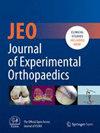Evaluating drill speed effects on tunnel diameter in ACL reconstruction: Insights from an experimental animal study
Abstract
Purpose
To determine how drilling speeds affect tunnel enlargement during cruciate ligament reconstruction.
Methods
Twelve adult female New Zealand rabbits, each weighing between 3 and 3.5 kg, were randomly assigned to two groups based on drilling speeds (400 RPM and 1500 RPM). Following sedation, the knee and tibia regions were shaved, and the knee joint was accessed using a medial parapatellar approach. The anterior cruciate ligament (ACL) was incised using a scalpel. Tibial and femoral tunnels were drilled with a 2 mm blunt-tip drill at the assigned group speeds. Room temperature saline was used for irrigation throughout the drilling procedure. An extensor tendon graft was harvested from the anterior cruris and sutured using the Krakow technique with 4-0 Vicryl. The graft was passed through the tunnel and secured to a pre-placed screw near the tunnels. Post-surgery, the operated extremity was not immobilised, and the rabbits were observed while moving freely within the cage. Twelve weeks post-operatively, the animals were humanely euthanized, and micro-computed tomography (CT) was employed to assess the diameters of the femoral and tibial tunnels at the proximal, middle and distal regions.
Results
No statistically significant differences were found between radiological femoral and tibial tunnel diameter measurements of the 400 and 1500 RPM drilling groups 12 weeks after arthroscopically assisted ACL reconstruction in New Zealand rabbits. However, within the 400 RPM group, there was a measurable increase in the tunnel diameter in the proximal tibia and distal femur regions.
Conclusion
The findings of our study suggest that concerns about higher drilling speeds in ACL surgery may be overstated, as higher speeds did not lead to significant radiological tunnel enlargement.
Level of Evidence
N/A.




 求助内容:
求助内容: 应助结果提醒方式:
应助结果提醒方式:


